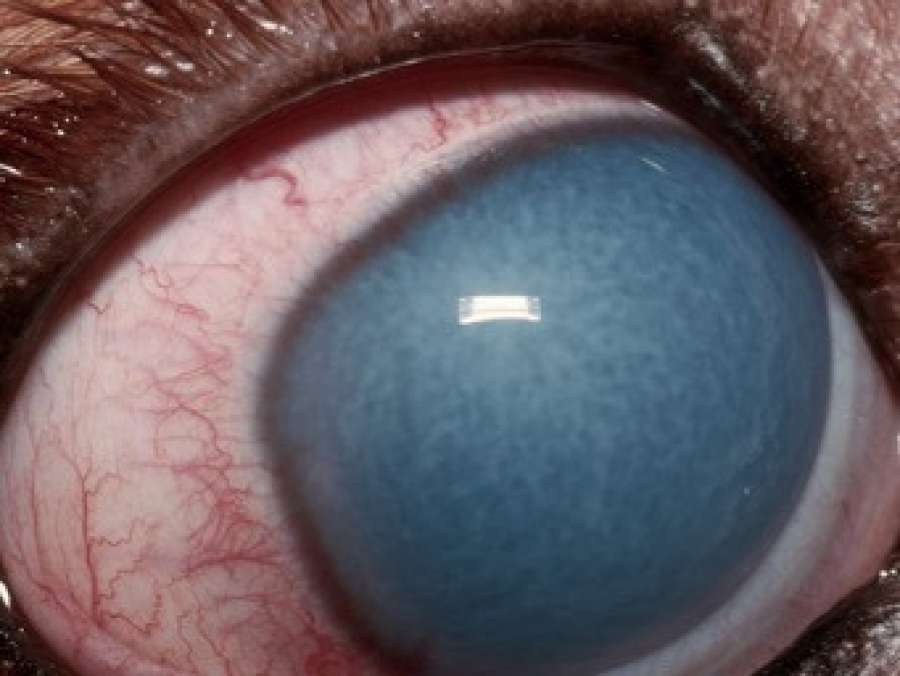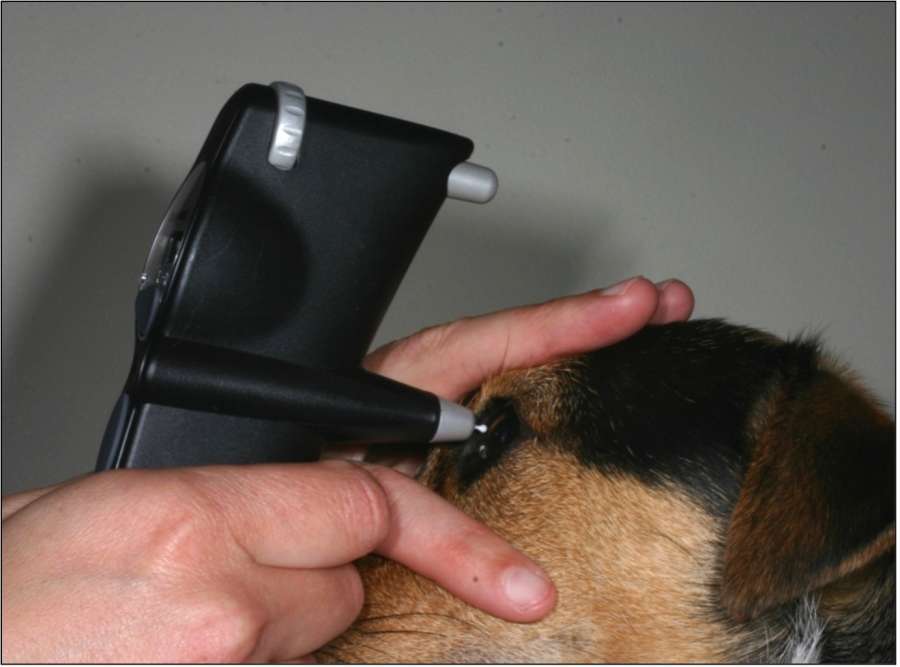Glaucoma
Glaucoma is when the optic nerve (connects the eye to the brain) and retina become damaged due to high fluid pressure within the eye. It’s a painful condition that causes blindness if left untreated.
Eye fluid and glaucoma
The ciliary body produces fluid that continually circulates within the eye. Fluid moves through the pupil and drains away just in front of the iris. A blockage to this drainage system causes eye pressure (intraocular pressure) to increase damaging the optic nerve and retina at the back of the eye.
Causes of glaucoma
Glaucoma can be primary (inherited from parents) or secondary (as a result of another eye condition). We commonly diagnose both forms in dogs but usually only secondary in cats (as a result of inflammation in their eye).
There are two forms of primary glaucoma:
- Primary closed angle glaucoma
- Primary open angle glaucoma (POAG)
Primary closed angle glaucoma
Goniodysgenesis is an abnormality of the drainage tissue within the eye. Dogs develop glaucoma when the angle formed between these tissues completely closes.
Any dog can have goniodysgenesis but some breeds are more likely to be born with it or develop it as they age (you can check the breed list below). Not all of these dogs will develop glaucoma but many do.
Primary closed angle glaucoma usually affects middle-aged dogs causing rapid, painful blindness.
If your dog has goniodysgenesis, we advise regularly eye checks to monitor for the early signs of glaucoma. At Focus, we can measure your dog’s drainage angle and assess whether treatment could delay or prevent the onset of glaucoma.
Primary open angle glaucoma (POAG)
Dogs with POAG usually show signs of glaucoma later in life and it develops more gradually than those with primary closed angle glaucoma. We can closely monitor your dog and prescribe anti-glaucoma drops to help control their intraocular pressures.
Secondary glaucoma
Conditions that can block the drainage system causing secondary glaucoma include:
- Cataracts and cataract surgery
- Uveitis (eye inflammation)
- Lens luxation
- Retinal detachment
- Eye tumours
What are the signs of glaucoma?
- Severe pain: squinting, blinking, depressed behaviour, watery eye
- Sudden blindness
- Blueish cloudiness over the front of the eye
- White part of the eye appears red
- Large, unreactive pupil
Primary glaucoma can affect one or both of your dog’s eyes. Usually if one is affected, the other eye will develop signs too.

Diagnosing glaucoma
At Focus, we carry out several tests to diagnose glaucoma.
- Intraocular pressure (IOP) measurement: an electronic gauge (called a Tonovet) quickly and painlessly measures IOP.
- Gonioscopy: we use a specialist lens to measure the eye’s drainage angle.
- An ultrasound scan allows us to look at all parts of your pet’s eye.
If your dog has goniodysgenesis, and their eye suddenly seems sore, please contact your vet as soon as possible to check whether they have glaucoma.


What treatment is available?
The aim of treatment is to make your pet comfortable and preserve their vision where possible.
Some dogs need an operation to remove their eye (enucleation) if they’re in pain and irreversibly blind. We then plan intensive, ongoing medical treatment to delay glaucoma in the other eye and preserve sight for as long as possible.
At Focus, we offer a procedure called micropulse trans-scleral laser therapy. This treatment reduces the production of fluid within the eye and lowers the risk of glaucoma developing.
Every pet is unique so requires their own, tailored treatment plan. Very occasionally we carry out surgery to place a drainage shunt in the eye with glaucoma. Only dogs with a reasonable amount of vision are suitable for this surgery and even then we may advise medical treatment instead.
If your dog has secondary glaucoma, we can diagnose the underlying cause and discuss the best treatment. (For example, removing their dislodged lens if they have lens luxation.)
Screening for primary glaucoma
If your dog is a ‘high risk breed’, we can regularly exam their eyes and monitor changes to the drainage angles and IOPs. We recommend gonioscopy every 3 years to pick up changes to their drainage angles. The sooner we detect the early signs of glaucoma, the more effective treatment can be.
Breeds with a higher risk of inheriting goniodysgenesis: Bassett Hounds, Border Collies, Dandie Dinmonts, Cocker Spaniels, English and Welsh Springer Spaniels, Flatcoat Retrievers, Golden Retrievers, Great Danes, Hungarian Vizlas, Japanese Shiba Inus, Leonbergers, Siberian Huskies, Spanish water Dogs, Welsh Terriers
Breeds with a higher risk of developing primary open angle glaucoma include: Basset Hounds, Petit Bassett Griffin Vendeens, Shar Peis
What are the complications?
Dogs with glaucoma need ongoing treatment and regular eye checks. Over time, even well-managed glaucoma will progress and may become uncontrollable with medication.
We can help you through each stage of this condition, ensuring your dog’s comfort and wellbeing is always at the forefront of our treatment plan.
If you’d like to find out more about how Focus can treat your dog’s (or cat’s) glaucoma, please ask your vet to contact us.

